
12-25 March 2019
I’m either too early or too late.
The best time to see the wisteria in Tokyo is mid-April to mid-May. So there I was in Tokyo on my first trip to Japan in 2018. It’s the end of April, perfect timing, and I’m disappointed to discover the wisteria bloomed early that year and I missed it.
All our research tells us that late February to early March is the best time to see the plum blossoms. Well here we are mid-March 2019 thinking we must have it just about right, or even be a little late for what in my imagination will be a full-on hallelujah of pink and white petals, like you see in photos of hanami for the cherry blossoms.

But alas the plum blossoms are late, most trees giving just the barest hint of their splendour.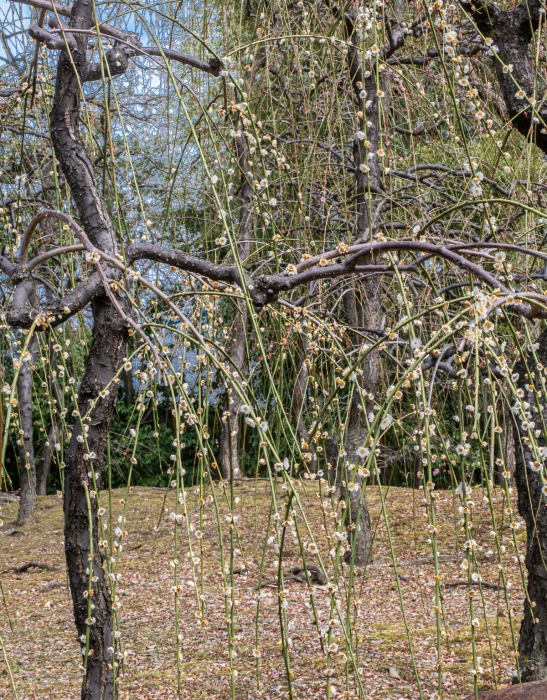
From the northwest of Kyoto to the south we went stalking plum blossoms, and found that only a few trees, among hundreds, were ready to show off.
Most were not yet willing to display themselves beyond a first shy glimpse, although the bright kimonos of local tourists often made up for it.
The Japanese have a huge veneration for nature and regard it as sacred, giving meaning to it in a way not generally found in western societies. I think we tend to see Japan as being paved over, but in reality there are huge swaths of wilderness, and even in urban areas, perhaps especially in urban areas, nature is everywhere and highly revered. Most temples and shrines have extensive gardens open to the public, and the design of the gardens and choice of plants almost always has deeper spiritual meaning than is obvious at first glance. Ikebana, the art of flower arranging, is also steeped in spiritual meaning.
It’s a bit of a long haul to get to Jonangu from our Airbnb in the Gion neighbourhood; a metro ride, then a train, then a long walk through paved grey streets made longer by the fact that we walk in the wrong direction for a while. It’s in the south of the city and not much visited by tourists so we have this lovely shrine complex, and it’s five late-winter gardens, almost entirely to ourselves except for a couple of gardeners painstakingly removing every last bit of invasive plant life from a moss lawn,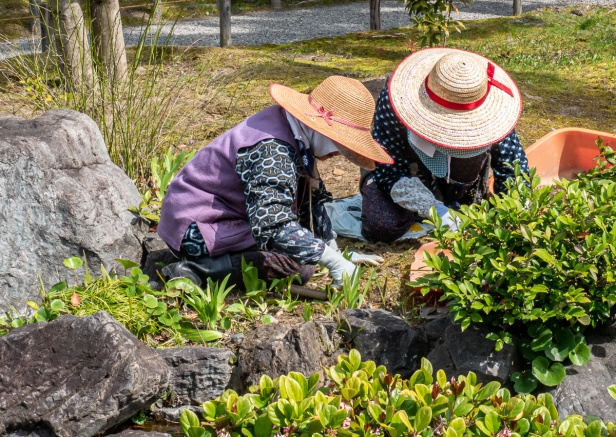
and a couple of pretty doves.
Of course we’re hoping for a riot of plum blossoms and although that aspect of the visit is somewhat disappointing there’s still plenty to enjoy.
Jonangu is famous for it’s weeping plums and camellias, and the entire series of strolling gardens feels like taking a journey back to the time of the Heian aristocracy. It has the ageless sense of a place made for the enjoyment of the wealthy, much like the early estate gardens of the British aristocracy that are now open to the public – vast spaces dedicated to beautifully cultivated gardens for the enjoyment of the nobility.
As with all shrines in Japan we enter Jonangu through an imposing grey stone torii gate marking the transition from the ordinary to the sacred. Our first encounter is with a Shrine Maiden, or priestess in her striking red and white outfit.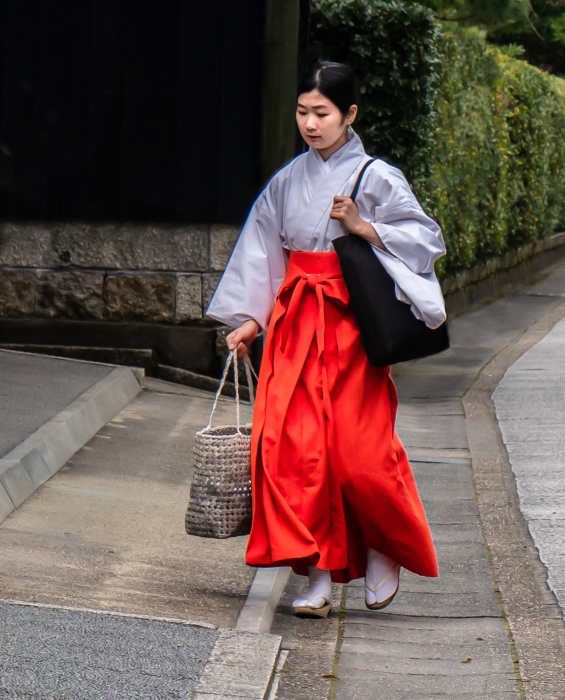
At various times throughout the year the priestesses perform sacred Kagura dances – enacting purifications and blessing participants with flowers.
A small lake,

a koi stream,
and a stone lantern
present beauty enough, as do the blossoms, even if they are as yet only half-hearted in their appearance.
And then there are the camellias.

Jonangu has 150 plum trees, and 300 camellia trees. Plum blossoms lose their petals, but the entire camellia flower falls to the ground sprinkling the soft chartreuse moss with vermillion accents.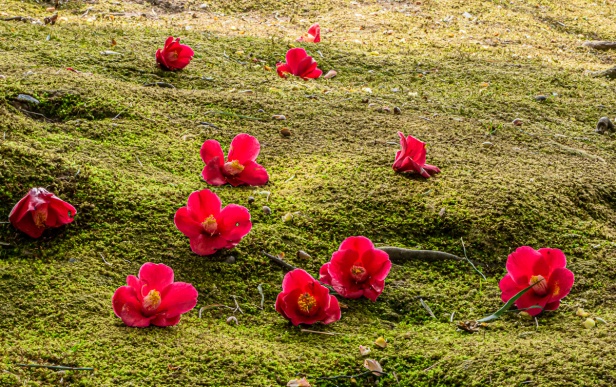

The samurai thought that the way the camellia flower falls resembles the way a human head falls when cut with a samurai sword, so they considered them unlucky, but no grisly story from the past can diminish their beauty.
Another day and another search for the elusive plum blossoms. This time we head to the northwest of Kyoto, to Kitano Tenmangu Shrine, a complex of buildings dating from the 1600s,


and a garden with 2000 plum trees!
So back in the late 800s there was this scholar, Sugawara no Michizane, who was an advisor to a couple of different emperors. At some point he fell out of favour with the ruling clan and was exiled to Kyushu where he died. I guess it didn’t pay to piss him off; after his death various calamities hit Kyoto and the imperial family – the plague, earthquakes, and thunderstorms, all of which were attributed to his angry spirit. Kitano Tenmangu Shrine was built to appease him, and he was deified as Tenjin, originally as the god of thunder, and later as the deity of scholarship. The current buildings date from 1607. In the serene gardens of the shrine, despite the lack of blooming plums, all is peaceful. Perhaps old Sugawara rests easy now.
A different kind of flower catches my eye. There are a few shrine maidens attending to their duties,
and several Japanese women wearing kimono. Apart from special occasions kimono are also quite often worn when sightseeing, and especially when visiting shrines. It is more likely to be older women but these days many young women, proud of their heritage, are also embracing the tradition.



And we do find some blossoms in a few favoured places.
Cherry blossoms grow in clusters, as opposed to plum blossoms, which grow directly from the stem.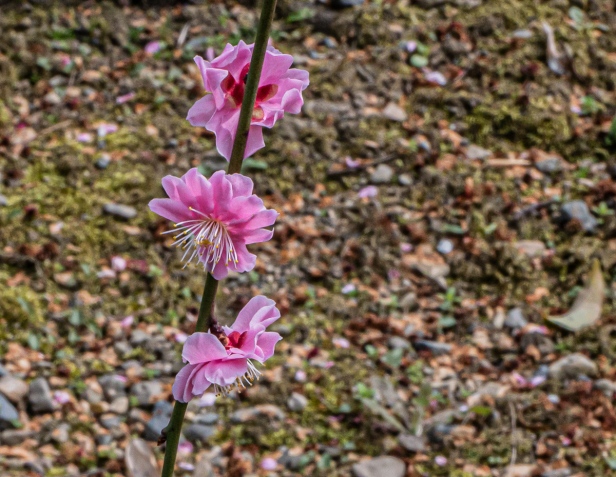

Tradition has it that plum blossoms protect against evil, and that evil often comes from the northeast, hence they are often planted in the northeast of a garden. Normally blooming from as early as mid-February, while it is still winter, the plum or ume blossom is revered and celebrated as endurance through adversity, the resilience of life, and faith that life will regenerate. They bloom even when there can still be snow falling, bringing colour to a desolate landscape and a reminder that spring will come. Known for their ephemeral beauty, for the Japanese they also signify great strength, and bear witness to the impermanence of everything.
We may not have seen the blossoms in all their glory, but there was beauty enough at these two beautiful shrine gardens to appease us as well as Sugawara no Michizane.

All words and images by Alison Louise Armstrong unless otherwise noted
© Alison Louise Armstrong and Adventures in Wonderland – a pilgrimage of the heart, 2010-2020.

Cherry blossoms are also a symbol of female power and that actually comes from China
LikeLiked by 3 people
Oh I didn’t know that. I like it!
Alison
LikeLiked by 2 people
Me too!
LikeLiked by 1 person
Awesome pictures and story, Alison. Thank you so much for sharing.
LikeLiked by 2 people
Thanks so much Carsten. Glad you enjoyed it.
Alison
LikeLike
Wonderful photos Alison!
LikeLiked by 1 person
Thank you!
Alison
LikeLiked by 1 person
Fraies in the trees.
LikeLiked by 1 person
Yes, exactly that. So beautiful.
Alison
LikeLike
What a lovely peaceful post, Alison. Japan and the kimono seem so exotic to western eyes. I’m currently reading a novel which starts with Nagasaki in 1945. Still hard to get your head around events of that time. I’m much happier with the blossoms, though I didn’t know that about fallen camelia. 🙂 🙂
LikeLiked by 1 person
Thanks so much Jo. I just love the kimonos, and I love that they still wear them, and apparently there’s even a resurgence among the young. Yes – so exotic! I’m glad to have presented you with a little respite from 1945 Nagasaki ( 😦 )
Alison
LikeLike
🤗💕💕
LikeLiked by 1 person
Alison – It’s hard to believe that the blossoms were later/early when your photos are so wonderful! And those walking paths on each side of the creek – amazing. How nice to celebrate your travel experiences in this time of staying close-ish to home. Cheers – Susan
LikeLiked by 1 person
Thanks so much Susan. I did mostly photograph those that were blooming. There were hundreds that were not 😦 but they’re still very beautiful gardens. I hope people are enjoying armchair travel until we can get moving again so I’ll just keep posting. I never seem to be able to catch up. As you can see I’m still posting about last year’s travels. BTW I’m loving Hannah!
Alison
LikeLiked by 1 person
Alison – Yes, ‘Hannah’ would be a good armchair travel companion. As much as I am getting tired of the continual stay-at-home, it does give a chance to catch up on past jaunts, and I am truly enjoying yours. Heard the smoke crawled up to you guys (sorry!) – hope you clear up soon. -Susan
LikeLiked by 1 person
Yes, we’ve had the smoke 😦 so sorry for CA/OR/WA It’s been better here today though. Hope things improve down there.
Glad you’re enjoying my jaunts.
A. xo
LikeLiked by 1 person
There are much worse things to do with your life than going in search of plum blossoms, Alison. 🙂 I appreciated your comment, “The Japanese have a huge veneration for nature and regard it as sacred…” Me too. —Curt
LikeLiked by 1 person
I agree! And, yeah, I was disappointed a bit. It should have been full blooming season but it was still worth it. I’m with you and the Japanese re nature.
Alison
LikeLike
Lovely, even if you didn’t hit the floral happy hour. The venerated parts of nature, and perhaps the temples and old castles; these are the things that would attract me to Japan, rather than the noise and nightlife of the cities.
LikeLiked by 1 person
Oh I love that – the floral happy hour! Well put. Temples, shrines, castles, gardens, and forest – all so beautiful in Japan, so lovingly cared for, and yes venerated. It took me a while to get their love of nature in the middle of Tokyo, but it’s definitely there. I did have some amazing experiences in the cities too though. Their festivals are usually spectacular and there are many of them. But rural Japan is really beautiful.
Alison
LikeLiked by 1 person
These are so beautiful, Alison. I love Japanese gardens for they feel not too manicured like French gardens. These set against sublime Japanese traditional architecture is just among the prettiest things in life.
LikeLiked by 2 people
Totally agree with you, Bama. The French gardens are indeed impressive, but they don’t have the tranquility of the Japanese gardens. I think they lack the closeness to nature 🙂
LikeLiked by 1 person
Thanks for sharing this beautiful post, Alison! It brings me back to my cherry-blossoms-stalking trip in 2018. I also came late, so most trees in Kansai had already bloomed. Fortunately, I visited Koyasan and found some magnificent cherry blossom trees there. Thanks to the cool weather, they were still in bloom 🙂
LikeLiked by 1 person
Thank you so much Len. I’m glad you enjoyed it. Lucky you to see them in full bloom!
Alison
LikeLiked by 1 person
Such a beautiful, civilized country! So many aspects of life there appeal to me, and the revering of nature is near the top of the list.
LikeLiked by 1 person
Isn’t it though! I do so love Japan. The reverence for nature for me also is near the top of the list. And the ingrained consideration for others, putting community first.
Alison
LikeLiked by 1 person
Never heard of this before, “Tradition has it that plum blossoms protect against evil, and that evil often comes from the northeast, hence they are often planted in the northeast of a garden” the bloom is definitely very beautiful. Your photos are great. Japanese women are very organic in their national clothes. I’ve never been to Japan …
LikeLiked by 1 person
Thanks so much Rosana. I read about the belief that plum trees ward off evil in several places – interesting symbolism. Maybe you’ll get to Japan one day. I highly recommend it. It’s one of my favourite countries.
Alison
LikeLike
Mother Nature may not have cooperated fully with your travel timing Alison but you captured some wonderful images. The camellias scattered on the ground are gorgeous, but what a horrible story for such beauty! Almost as lovely as nature are those Shrine Maidens…wow do those colours pop!
LikeLiked by 1 person
Thanks so much Caroline. We did certainly see a few trees that were ahead of their time, but most were showing not more than buds. Still, it was worth visiting both places for their other beauties, like the camellias! I wish we’d been there at the right time to see the Shrine Maidens perform.
Alison
LikeLiked by 1 person
It’s always tough to time visits with nature’s spring (and autumn) spectacles. Even one day can make a difference. Your photos are still delightful. The severed camellias on the ground is my favorite image. Love that color contrast.
LikeLiked by 1 person
Thanks so much Julie. It was strange that they were so late. I have no idea why, but it seems we’d have had to be there about a week or so later to see them at their best. Still, what we did see was very lovely. And yes, the camellias – so beautiful against the moss.
Alison
LikeLiked by 1 person
Alison, there are few things more splendid than a Japanese garden – and your gorgeous photography just makes me take a deep breath … exhale … and be. How wonderful it must have been to walk through those gardens. Thanks so much for taking us with you. ~Terri
LikeLiked by 1 person
Thank you so much Terri. My pleasure! I’m glad you came with us into a little bit of Japan’s peaceful beauty.
Alison
LikeLiked by 1 person
What a fun post! The beautiful shrine maidens reminded me a bit of my monk obsession in southeast asia. Japan is such a beautiful country. I also loved your account of how difficult the journey was to get to Jonangu – one of the fun memories though of travel!
LikeLiked by 1 person
Thanks so much Heather. I was the same with the monks! And with the shrine maidens, and priests, and anyone in traditional dress in Japan. I suppose because to me it’s quite exotic. And beautiful.
Despite it being a bit of a long haul to Jonangu (and apparently there’s a bus we could have taken that would have been easier lol) and that most of the trees were barely (or not at all) blooming it was still worth it. Japanese gardens are so serene. Japan is one of my fave countries.
Alison
LikeLiked by 1 person
Would have come back this week from Japan… oh so beautiful the reds and silky feeling you created here Alison…and your narratives are the best! Smiles and joy your way ~ hedy
LikeLiked by 1 person
Thanks so much Hedy for your lovely words. I like what you said about it having a silky feeling. So sorry you missed your trip to Japan! 😦 Have you been before? It’s one of my favourite countries.
Alison
LikeLiked by 1 person
Everybody’s missed something…seems nothing in the big picture but yes of course I’d love to see it again…just one time…I also appreciated what I experienced…yes the red silk in particular ☺️❣️👌
LikeLiked by 1 person
The blossoms are so beautiful.
I really need to visit Japan someday. I would really enjoy all these gardens and things.
LikeLiked by 1 person
Blossoms in Japan seem to be extra special that’s for sure. It’s the way they care for them I think, and the spiritually imbued meaning. It’s the Japanese way. I hope you get there one day – it’s an amazing place.
Alison
LikeLike
Yes, I believe so.
I always enjoy your photos from Asia. They really give an insight to places I haven’t been to so far.
LikeLiked by 1 person
What an incredible post ~ wow. The second photo is like something out of a fairy tale, just brilliant and surreal. It seems the difficulties of the journey was well worth it ~ and you seem to have captured the essence of the Kyoto shrines.
LikeLiked by 1 person
Thanks so much Randall. The second photo is what we were hoping to see. The height of the blooming season was quite late last year when we were there so we missed it. Still the gardens are beautiful in that quiet elegant Japanese way where every blade of grass seems to be blessed and respected. Shrine gardens all over Kyoto are special places and exude a kind of reverence that is unique to Japan I think.
Alison
LikeLike
You made the best of it…actually, those earliest buds are so beautiful, with all the promise they carry. Plum blossoms are a symbol for the Soto Zen school, which the monastery where I practiced years ago was part of. There are wonderful but rather inscrutable writings by Dogen Zenji (the founder of Soto Zen) centering on plum blossoms.
It’s fun to see the ladies in their kimonos, some very proper, some more everyday. The photo of the camellia blossoms scattered across that green, green lawn is my favorite – wow, so beautiful! I always appreciate the amount of history and factual information you include in these posts too, Alison.
LikeLiked by 1 person
Thanks so much Lynn. I guess I did make the best of it though I admit I was disappointed. But there was so much beauty anyway that I couldn’t be unhappy for too long. And what blossoms there were were so lovely. I agree about the photo of the camellia blossoms on the moss lawn – the second photo with trees in it – is definitely one of my favourites too.
I like the research, though I have a pretty short attention span for it. I’m always looking for the interesting background stories to explain why things evolved the way they did. It’s fun. Up to a point lol.
Alison
LikeLiked by 1 person
It takes time and sucks you in which is why, as you said, it’s fun up to a point. 😉
LikeLiked by 1 person
Aaah, what beautiful gardens! I’m lamenting the passing of summer (I need another month or two to be ready for fall and winter), and somehow these pictures make me hopeful once more. Sorry you didn’t get to see the blossoms in full glory, but oh – that shot of the koi stream is delightful!
LikeLiked by 1 person
I also feel not ready for the end of summer 😦 It seemed to go so quickly this year and here in Vancouver it was a bit more rainy and less warm than usual. Still, I’m slowly starting to appreciate the arrival of the fall colours.
I too enjoyed the koi stream – such a traditional part of Japanese gardens, and the many other beautiful aspects of the gardens even without the full blooming of the plum trees. For sure I’m glad we went!
Alison
LikeLike
Thank you for this peaceful escape to Japan. I so love seeing the kimonos and I especially love the gentleman’s black and beige striped coat. I can so relate to your disappointment about not-quite-right timing for the blossoms. We’re leaving on a camping/road trip next week and I think we’re going to be a little late for the fall colors, sadly. But we’ll see! Still, it will be nice to be out of the house in nature!!
LikeLiked by 1 person
My pleasure. Seeing the kimonos is always lovely, and I especially love it when the men dress up too. I’ve occasionally seen a solo man in traditional dress, but you see it quite frequently with couples. I too love his striped jacket.
Have fun on your trip! May the weather be on your side.
Alison
LikeLiked by 1 person
Thanks Alison!!
LikeLiked by 1 person
I enjoyed Japan alot …as a tourist, Alison.
But could never live there for long. The society is still very hierarchical …for feminist..it would not sit well.
Then when we went to Seoul for a few days, I could feel abit of those society strictures experienced in Japan, loosen abit in Seoul.
LikeLiked by 1 person
There’s an odd disconnect between my post about plum blossoms and your comment Jean. Oh well. It is what it is. I felt nothing of what you speak, and I’m certainly a feminist. I loved Japan. My sister, also a feminist, lived there for 3 years and I have two friends, one American, one Australian, both feminists, both of whom have lived there for many years, and all three of these women dearly love Japan. I’m not saying Japan’s not a patriarchy. Of course it is. I just don’t think it’s any worse than most countries and a great deal better than India, Pakistan, Saudi Arabia, etc. I never felt any society strictures when I was there. I’ve not been to Seoul, but watch a lot of K-dramas. Certainly the gender roles are still pretty stereotyped, but I doubt Korea is any better than Japan re the place of women in society, and that neither country is worse than most countries.
Alison
LikeLike
It may be better than India, etc. For sure. I disagree. It sure felt like alot of self-restraint how Japanese women and girls must behave. I actually feel sorry for university educated Japanese women…it’s harder for many of them to move ahead and up the ladder in working world. It wouldn’t surprise me, the Japanese adults we see at the ESL private schools in Vancovuer feel a whole lot freer in Canadian society. I don’t expect yourself to feel it, Alison. That’s all.
LikeLiked by 1 person
You’re not Japanese and were only there as a tourist, so if you didn’t expect me feel it why did you?
I’m guessing you went to Japan with a lot of pre-conceived notions about the culture, and so because you expected to find things difficult for the women you were hyper-sensitive to it.
As for university educated Japanese women finding it harder to move up the corporate ladder it’s the same in all patriarchies. Or hadn’t you noticed?
A.
LikeLike
Sure, some patriarchy in our current system. But I sincerely believe it’s just less of the fetch-coffee culture now.
I did blog an experience in the business district at a ramen place in downtown Tokyo. It actually surprised me and as we walked the streets, seeing nothing but 95% guys, disappointed, if not also repelled me. My partner went with me to eat also. We also went to same place/district again but left because of no smoking was not in effect. https://cyclewriteblog.wordpress.com/2018/10/01/food-art-tofu-doughnuts-and-octopus-kimchee-pancake-japan-and-seoul-south-korea/ I will say for sure, in Bay St., Toronto’s financial district you wouldn’t get 95% male dominant customer group in a restaurant…Canada’s national headquarters for all our banks and law firms. I worked in that district for several years in Toronto.
Anyway, these guys weren’t managers in the Tokyo restaurant. Just workers that’s how they network all the time after work. So we strolled by the restaurants…office dressed workers…barely…any women have a meal/drink with the guys. It’s not the same in the financial district in Canada. It may well be comparable….at oil sands operations in northern Alberta.
A Chinese-CAnadian friend did teach /work in Japan for a year. It was the same restraint she felt there among the Japanese. It’s not terrible, just confining in terms of natural self-expression and expressing one’s opinion, especially if one is a woman. As I said, I enjoyed Japan only as a tourist. Of course often mainland Chinese women are different…many will say what is on their mind…directly.
Most of my jobs for past 35 yrs., my employers were male dominant …engineering and legal sectors in CAnada. I worked with firefighters also as well engineers, lawyers and judges, Alison. I still think it is easier in CAnada even with the hard work and networking required for women to forge ahead.
LikeLiked by 1 person